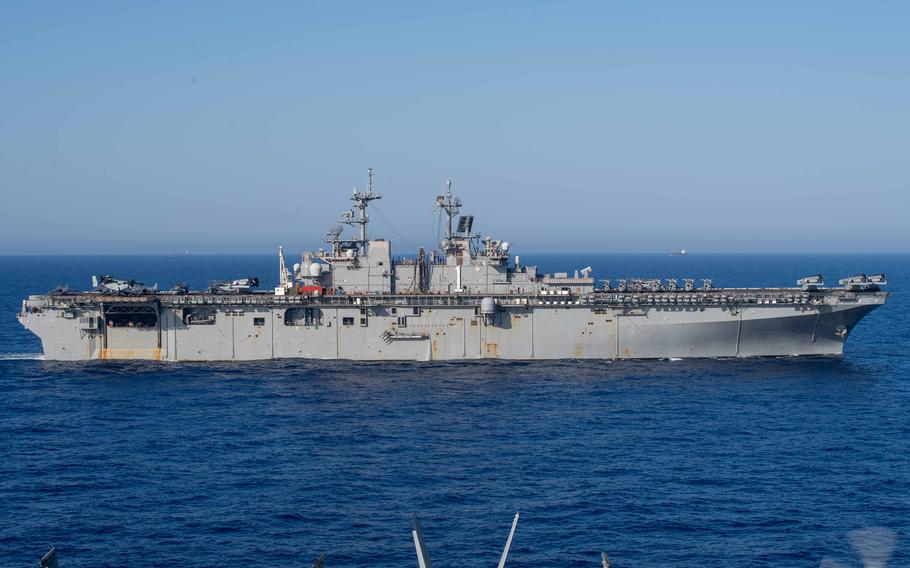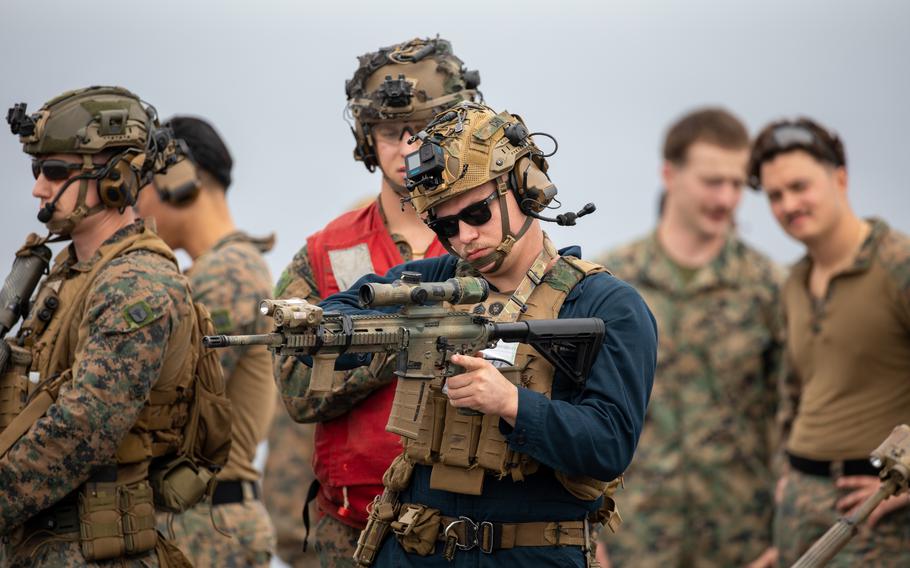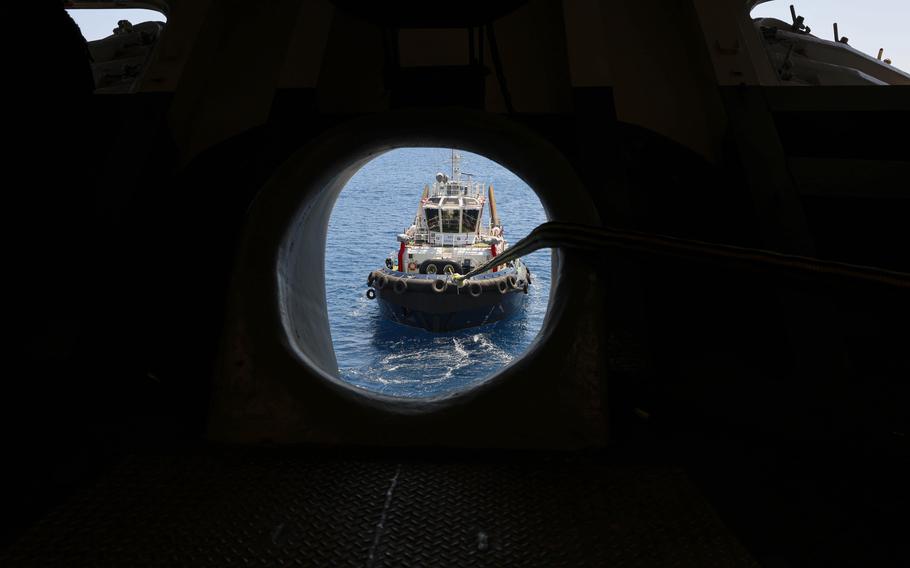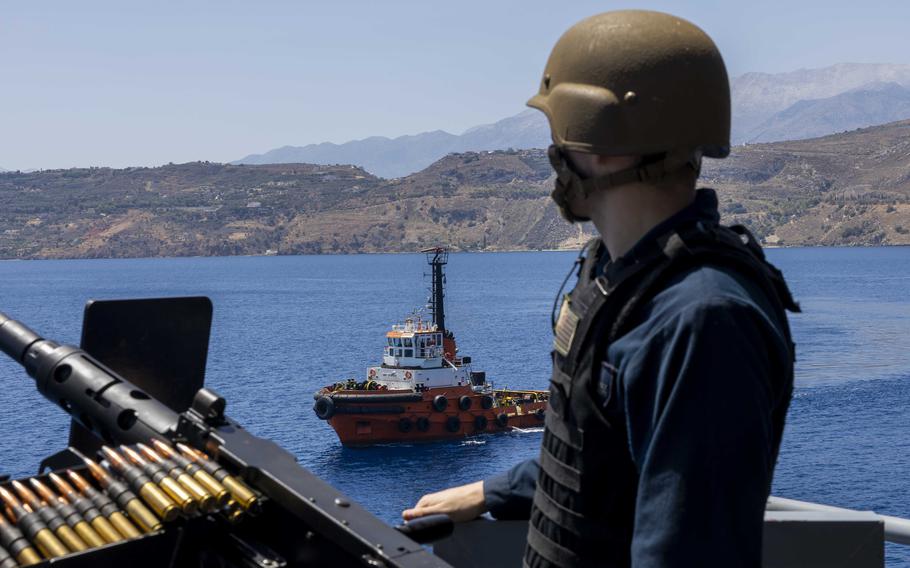
The amphibious assault ship USS Wasp steams in the Mediterranean Sea on June 30, 2024. The ship made a July 8 port call at Souda Bay, Greece, ahead of a deterrence mission in the eastern Mediterranean Sea and Middle East. (Nicholas Rodriguez/Navy)
NAPLES, Italy — The amphibious assault ship USS Wasp made its first port call in Europe this week to allow sailors and Marines some rest ahead of a busy deployment, as the Pentagon works to deter a wider conflict in the Middle East.
Wasp’s visit to Naval Support Activity Souda Bay on the Greek island of Crete comes more than a month after it began its deployment, and shortly after it relieved the Dwight D. Eisenhower Carrier Strike Group in the eastern Mediterranean Sea earlier this month.
After months of cross-border conflict, fears are increasing of a war between Israel and the Lebanon-based militant group Hezbollah. Israel has warned that the time for a diplomatic solution is short as it prepares for escalation.

Marines with the 24th Marine Expeditionary Unit and sailors assigned to the amphibious assault ship USS Wasp conduct weapons drills on the flight deck while in the Mediterranean Sea on June 27, 2024. Wasp pulled into Souda Bay, Greece, on July 8. (Elton Taylor/Marine Corps)
In announcing the Wasp Amphibious Ready Group’s deployment to the region last month, Pentagon spokesman Maj. Gen. Pat Ryder said it would serve as a deterrent and enable the military to respond to a multitude of contingencies.
The Defense Department has mostly kept a carrier strike group or amphibious ready group in the eastern Mediterranean since Hamas attacked Israel on Oct. 7.
The Wasp group, which includes the amphibious transport dock ship USS New York and dock landing ship USS Oak Hill along with elements of the 24th Marine Expeditionary Unit, arrived in the Mediterranean late last month.

A tugboat positioned in front of the ship’s forecastle assists in maneuvering the amphibious assault ship USS Wasp into Souda Bay, Greece, July 8, 2024, for a port call. (Soren Quinata/Navy)
It has more than 4,500 sailors and Marines, and flies the MV-22 Osprey and AV-8B Harrier, among other aircraft. The Wasp also is capable of supporting the F-35 fighter jet.
Meanwhile, the Theodore Roosevelt Carrier Strike Group entered the U.S. 5th Fleet area of operations on Friday, U.S. Central Command said in a post to its X account.
The strike group includes the cruiser USS Lake Erie and the destroyers USS John S. McCain, USS Halsey and USS Daniel Inouye, USNI News reported on Monday.

Petty Officer 3rd Class Connor Hall mans a gun mount as USS Wasp pulls in to Souda Bay, Greece, July 8, 2024, for a port call. ( Sydney Milligan/Navy)
Earlier this month, the U.S.-led Joint Maritime Information Center reported the second-highest monthly number of Houthi attacks on ships in the Red Sea, Gulf of Aden and Bab el Mandeb since November, according to the center’s report for the week ending July 6.
There were 17 attacks on vessels in the region in June, including a missile and surface drone attack on a cargo ship in the Red Sea that ultimately sank the vessel.
On June 13, three Houthi missiles targeted another vessel in the Gulf of Aden, causing a fire and requiring rescue of the crew, the Joint Maritime Information Center said.
By comparison, there were six and four attacks, respectively, in April and May, according to the report. The center, part of the 44-nation Combined Maritime Forces based at Naval Support Activity Bahrain, recorded 19 attacks in December.
“June reached levels not seen since December of 2023,” the center said.
All told, there have been at least 74 incidents, including attempted attacks and hijackings, since the Houthis began their campaign on Nov 19. Those attacks have killed four mariners and severely injured two others, according to the report. Two ships have sunk.
The numbers do not include engagements with coalition forces, the center said.
Analysts also have noted an increase in the Iran-backed group’s use of unmanned explosive-laden boats like those employed by Ukraine in its attacks on Russian warships in the Black Sea. Without a traditional navy, Ukraine has sidelined nearly one-third of the Russian Black Sea Fleet.
On Thursday, CENTCOM announced that U.S. forces had destroyed five Houthi surface drones in the Red Sea.
Since June 30, U.S. forces have destroyed 13 surface drones and eight aerial drones launched by Houthi militants and destroyed four of the group’s radar sites in Yemen. Two other Houthi aerial drones were destroyed by partner forces, according to CENTCOM.
“The Houthi maritime campaign has been well-planned,” said Washington Institute senior fellow Noam Raydon in a Wednesday post to her X account. “This campaign has become more lethal, and different weapons have been used, with a notable increase in the use of (unmanned surface vehicles) since June 5, 2024.”
The Wasp Amphibious Ready Group began deployment operations in the Atlantic Ocean on June 1.